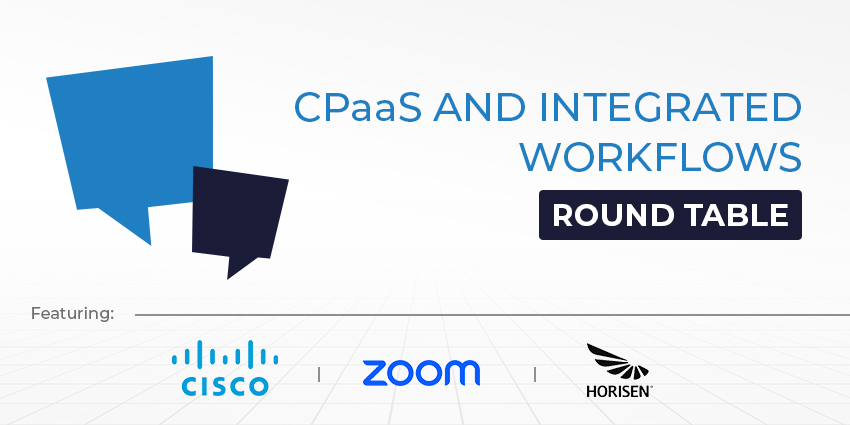The space of CPaaS and integrated workflows in UC and collaboration continues to evolve swiftly. With technological advancements underpinning seamless connectivity and enhanced user experiences, organisations are leveraging CPaaS to streamline communication processes and integrate them into broader workflows. From real-time messaging to video conferencing and beyond, the integration of CPaaS into UC platforms offers unprecedented flexibility and efficiency.
For our latest Round Table topic, “CPaaS and Integrated Workflows,” we spoke with experts and executives from Cisco, Zoom, and HORISEN about trends and advancements in CPaaS technologies, the primary considerations organisations should have when evaluating CPaaS providers, the role of emerging technologies like AI, automation and IoT in enhancing CPaaS capabilities, and the future trajectory of CPaaS.
What recent trends or advancements have been made in CPaaS technologies that have significantly impacted the efficiency and effectiveness of integrated workflows?

Helen Hawthorn, Head of Solution Engineering EMEA at Zoom
Hawthorn stressed that new APIs and AI advancements have brought about enormous benefits.
“The latest APIs make it much easier for businesses to use CPaaS to augment their existing applications,” Hawthorn said. “These low-code/no-code API tools mean businesses can now create much more dynamic internal communications or customer journeys by quickly implementing one-off tools or making customisations with multiple APIs under a single platform.”
Hawthorn continued by highlighting the integration of CPaaS with AI has allowed companies to further enhance the way they map customer journeys, automate tasks and gather insights from internal and customer interactions.
“With new developments in how CPaaS can be integrated, companies can now build their own chatbots and enhanced self-service experiences, for example, and AI tools are set to allow more personalised interactions for next-level marketing and sales automation,” Hawthorn said.
“Such technology advancements have enhanced the initial core ability of CPaaS to optimise internal communications and customer service efficiently and cost-effectively while revolutionising the way businesses interact.”
Fabrizio Salanitri, CEO at HORISEN
Salanitri emphasised that one of the most significant impacts on the efficiency and effectiveness of integrated workflows in CPaaS technologies is AI-powered chatbots.
“CPaaS platforms integrate AI and machine learning to automate communication processes,” Salanitri said. “Chatbots handle inquiries, offer recommendations, and complete transactions, optimizing operations to efficiently serve thousands of customers simultaneously, reducing wait times and enhancing customer satisfaction.”
Brian Heikes, Director of Product Management, Webex CPaaS Solutions at Cisco
Heikes suggested one of the most significant transformative CPaaS trends has been the infusion of AI and ML, as they empower smarter and more efficient communication systems.
“AI-driven chatbots and virtual assistants are being used more and more, offering personalized customer interactions in real time without the need for human intervention,” he said. “ML algorithms can provide intel to optimize customer engagement strategies through their analytic offerings.”
What are the primary considerations organizations should keep in mind when evaluating CPaaS providers and selecting the right solution for their integrated workflow needs in 2024?

Fabrizio Salanitri, CEO at HORISEN
Salinitri argued that organisations should primarily consider improved technology accessibility.
“This involves prioritizing user-friendliness and an open API approach in CPaaS development,” Salanitri continued. “An intuitive interface tailored to users with varying technical expertise is essential. Moreover, organizations should look for providers that embrace diverse APIs for seamless integration, emphasizing the importance of ‘open box’ solutions.”
Salanitri added that robust APIs empower users to effortlessly orchestrate workflows, establish channels, interface with chatbots and automation platforms, and efficiently manage contact data.
“This streamlined interaction not only fosters automation across messaging apps but also advances the ultimate objective of seamless automation for businesses of all sizes, all within a single platform,” he added.
Brian Heikes, Director of Product Management, Webex CPaaS Solutions at Cisco
For Heikes, when considering different CPaaS providers, companies should prioritise APIs and SDKs, end-to-end automation, and security.
“Since customers expect to be met on the channels that they already use, its important that the CPaaS provider has a wide range of APIs spanning across all communication channels and to make sure the service is compatible with any user’s device,” Heikes explained.
“While you can support multiple communications channels individually, enterprise-grade CPaaS platforms, such as Webex Connect, enable businesses to automate, orchestrate and monitor interactions at scale to deliver an end-to-end customer journey across multiple channels.”
Data security cannot be compromised, so Heikes stressed that companies must check whether the provider complies with all local data laws and has certifications showing its expertise in data security.
Helen Hawthorn, Head of Solution Engineering EMEA at Zoom
Hawthorn highlighted that with many providers offering a standard feature set, it’s important to consider the different capabilities and levels of support available.
“To evaluate the right provider, businesses must first define exactly what your communications needs are and analyse the available CPaaS capabilities against your integrated workflow needs,” she said. “Use each of these criteria to weigh each area of differentiation based on the importance to your requirements.”
Hawthorn expanded, noting that organisations should look at the comms channels they need with customer support, price and feature considerations.
“They should also think about global support and reach around the geographical regions you operate within,” Hawthorn added. “You can then start looking at integration capabilities against your existing systems and how scalable each provider is in terms of your future needs before checking security and compliance considerations.”
“Lastly, look for a provider that takes full advantage of new AI capabilities and offers the flexibility to allow you to customise your workflows in line with your specific current and future business needs.”
What role do emerging technologies, such as AI, machine learning and IoT play in enhancing CPaaS capabilities for integrated workflows in the UC&C industry?

Brian Heikes, Director of Product Management, Webex CPaaS Solutions at Cisco
Heikes observed that AI and ML have always been key features within CPaaS to enable chatbots and self-serve capability. However, to remain relevant, he emphasised that CPaaS must stay ahead of the curve by introducing emerging technologies, such as Gen AI. Gen AI has many applications within CPaaS, both as a content engine and to enhance efficiency across the experience.
“For example, it can enable faster coding for developers so that innovations and updates can reach the market quickly,” Heikes said. “As a result, developers can also spend their time on more complex codes while AI takes on easier and more frequent requests, such as social hour checking.”
“AI can summarize and pull-out key points from transcripts for internal teams or customers, as well as automate FAQs and interpret key data points and trend as an analytics tool. Despite the popular belief that AI will replace knowledge workers, AI only stands to augment the capabilities of live agents. Humans remain an essential part of the overall customer journey.”
Helen Hawthorn, Head of Solution Engineering EMEA at Zoom
Hawthorn explained that AI now allows businesses to map their customer journeys, automate routine tasks and collect insights from internal and customer interactions with unprecedented efficiency.
“By offering access to customisable tools, businesses can enhance their workflows,” Hawthorn clarified. “CPaaS integrations mean companies can now build their own chatbots and enhanced self-service experiences, and AI tools are set to allow more personalised interactions for next-level marketing and sales automation.”
Hawthorn also observed that the growth of IoT-enabled devices has boosted CPaaS with new capabilities for business operations, with new ways to engage employees and customers alike.
“The relationship between the analytical power of AI and IoT’s interconnectivity capabilities will transform CPaaS capabilities in the UC&C industry,” Hawthorn said.
Fabrizio Salanitri, CEO at HORISEN
Salanitri noted that emerging tech like AI, machine learning, and IoT are pivotal catalysts in advancing CPaaS capabilities for integrated workflows within UC&C.
“AI enhances customer engagement by empowering AI-driven bots to handle routine inquiries, offer personalised recommendations, and autonomously complete transactions,” Salinitri said. “This proactive approach not only fosters increased customer satisfaction but also streamlines communication processes.”
Looking ahead, what do you foresee as the future trajectory of CPaaS and its impact on the evolution of UC&C strategies and digital workplace experiences?
Fabrizio Salanitri, CEO at HORISEN
Salinitri highlighted that, with the integration of advanced technologies like AI, CPaaS is positioned to optimise and digitalise processes that were previously challenging to streamline.
“This enhanced accessibility will enrich customer-brand interactions, driving growth and fostering improved engagement,” Salanitri said. “Continued expansion and market growth are anticipated, especially in conversational commerce.”
“The CPaaS market is forecasted to maintain its upward momentum, Salanitri added, “propelled by increasing demand for integrated communication solutions and the widespread adoption of digital transformation initiatives across various industries.”
Helen Hawthorn, Head of Solution Engineering EMEA at Zoom
For Hawthorn, CPaaS solutions are becoming increasingly valuable to business decision-makers as agility and flexibility become key strategic imperatives.
“With further technology advances in areas like IoT, edge computing and 5G connectivity, we’ll see CPaaS enable the digital workplace to operate with unprecedented levels of speed and efficiency,” Hawthorn explained.
Hawthorn also suggested that AI’s impact on the digital workplace and communication tools will also see workers empowered with enhanced ways of interacting with customers, automation of many routine tasks and a far more personalised digital workplace experience.
“As a broader range of business sizes and types follow the digital transformation trajectory, we’ll also see CPaaS being adopted on a much wider scale and across different industries as they seek to streamline their communications and digital workplace experiences,” she concluded.
Brian Heikes, Director of Product Management, Webex CPaaS Solutions at Cisco
While Heikes observed that the essence of CPaaS will always be enabling enterprises to meet their customers where they are—on the communication channels of their preference—there is an increasing need for a seamless, easy-to-use experience between digital communication channels such as WhatsApp and UC tools such as Webex App.
“Webex Connect is already enabling this for customers and their employees today where digital comms channels are an extension of the Webex App, allowing for asynchronous chat across multiple channels and communication across multiple teams organization-wide,” Heikes said.
Furthermore, consumers are required to use their channel of choice for communicating with a brand, which may entail communicating with an expert such as a finance broker who would use a UC tool such as the Webex App.
“Again, there needs to be a secure, seamless experience between the digital comms channel and the UC tool,” Heikes added.







